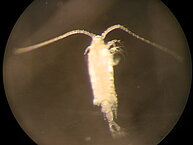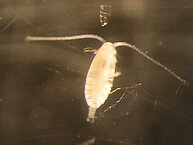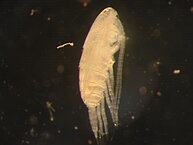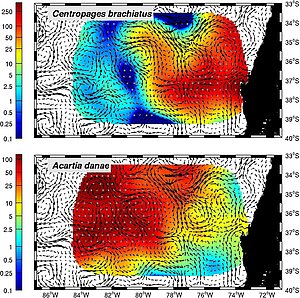Crustaceans off Chile
Image of the Month - October 2011
The Humboldt current system is one of the most fertile ocean area, caracterized by a cold current, and a strong upwelling off the coasts of South America. Quite a number of marine species are flourishing there, including copepods, very small (~1-2 mm long) crustaceans which are a dominant component of the zooplankton in all oceans.
During an oceanographic campaign, zooplankton samples were taken (top 100 m depth) off central Chile and analyzed. These data were used to map the abundance of copepods, as total and by species, and to associate them with satellite-monitored environmental data, including geostrophic currents computed from altimetry. It seems that mesocale features, such as eddies, contribute to the dispersal of some of the copepod species away from the coast (up to 500 km). This type of information enable us to better understand plankton distribution and with it the most basic part of marine food webs.



Photographs of some of the copepod species studied (left Centropagesbrachiatus, middle Nannocalanus minor, right Calanoides patagoniensis). These small crustacean are about 1 or 2 mm long. (Credits Dr. Ruben Escribano Centro COPAS, Universidad de Concepción, Chile)
See also:
- Image of the Month, July 2001: Altimetry and lobsters
- Applications: Biology
- Data: <link en data product-information duacs index.html _self internal-link>Ssalto/Duacs near-real and delayed time multimission altimeter products
References
- Morales, C.E., M.L. Torreblanca, S. Hormazabal, M. Correa, S. Nuñez, P. Hidalgo. 2010. Mesoscale structure of copepod assemblages in the coastal transition zone and oceanic waters off central-southern Chile. Progress in Oceanography 84, 158-173





